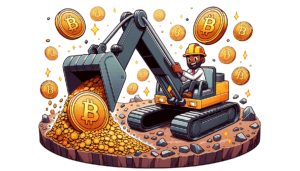Blockchain in Education
Blockchain is a distributed database that is used to maintain a continuously growing list of records, called blocks. Each block contains a cryptographic hash of the previous block, a timestamp, and transaction data. Blockchains are typically managed by a peer-to-peer network collectively adhering to a protocol for inter-node communication and validating new blocks. Once recorded, the data in any given block cannot be altered retroactively without the alteration of all subsequent blocks, which requires collusion of the network majority.
Blockchains are often used as a distributed ledger, where the data is stored across multiple nodes, making it difficult to tamper with. This makes blockchain a promising technology for use in education, where it can be used to securely store student records, track academic progress, and manage financial transactions.
Here are some of the benefits of using blockchain in education:
- Increased security: Blockchain is a tamper-proof distributed ledger, which means that it is very difficult to alter or delete data once it has been added to the blockchain. This makes it an ideal solution for storing sensitive student data, such as academic records or financial information.
- Transparency: All transactions on the blockchain are recorded in a public ledger, which means that everyone can see how the data is being used. This transparency can help to build trust between students, teachers, and administrators.
- Immutability: Once data is added to the blockchain, it cannot be altered or deleted. This immutability can help to ensure that student records are accurate and cannot be tampered with.
- Cost-effectiveness: Blockchain is a decentralized technology, which means that it does not require a central authority to operate. This can help to reduce the cost of managing student records and tracking academic progress.
Despite the potential benefits of using blockchain in education, there are also some challenges that need to be addressed. These challenges include:
- Complexity: Blockchain is a complex technology, and it can be difficult to understand and implement. This complexity can make it difficult for educators to adopt blockchain in their classrooms.
- Lack of standards: There are currently no universally agreed-upon standards for blockchain in education. This lack of standards can make it difficult to integrate blockchain with existing educational systems.
- Regulation: The regulatory environment for blockchain is still evolving. This uncertainty can make it difficult for educators to adopt blockchain in their classrooms.
Despite the challenges, the potential benefits of using blockchain in education are significant. As the technology continues to mature, we can expect to see more and more innovative applications of blockchain in the education sector.

What is blockchain?
Blockchain is a distributed database that is used to maintain a continuously growing list of records, called blocks. Each block contains a cryptographic hash of the previous block, a timestamp, and transaction data.
Blockchains are typically managed by a peer-to-peer network collectively adhering to a protocol for inter-node communication and validating new blocks. Once recorded, the data in any given block cannot be altered retroactively without the alteration of all subsequent blocks, which requires collusion of the network majority.
In this way, blockchains provide a secure and tamper-proof way of storing data. This has led to a number of potential applications for blockchain technology, including but not limited to:
Digital currency
Smart contracts
Supply chain management
Identity management
Voting systems
Blockchain technology is still in its early stages of development, but it has the potential to revolutionize a wide range of industries. It is important to note, however, that blockchain is not without its challenges. For example, blockchains can be slow and inefficient, and they can be difficult to scale. Additionally, blockchains are not inherently private or secure.
Despite these challenges, blockchain technology is a promising new technology with the potential to change the world.
How blockchain works
Blockchain is a distributed ledger technology that maintains a continuously growing list of records, called blocks. Each block contains a cryptographic hash of the previous block, a timestamp, and transaction data.
When a new block is added to the blockchain, it is broadcast to all of the nodes in the network. The nodes then verify the new block by checking the cryptographic hash and the timestamp. If the block is valid, it is added to the blockchain.
This process ensures that the blockchain is tamper-proof and that all of the transactions that are recorded on the blockchain are accurate.
Blockchain is a powerful technology that has the potential to revolutionize many industries. It is already being used in a variety of applications, such as supply chain management, financial transactions, and voting.
As the technology continues to develop, we can expect to see even more innovative applications for blockchain.
Benefits of blockchain
Blockchain technology offers a number of benefits for the education sector, including:
Security:
Blockchain is a secure and tamper-proof way to store data. This can be beneficial for schools and universities that need to protect student records and other sensitive information.
Transparency:
Blockchain is a transparent and immutable way to track transactions. This can help to improve accountability and trust in the education system.
Immutability:
Blockchain is an immutable ledger, which means that data cannot be changed or deleted. This can help to ensure the accuracy and reliability of data.
Cost-effectiveness:
Blockchain can be a cost-effective way to manage transactions and record data. This can be beneficial for schools and universities that are looking to save money.
Scalability:
Blockchain is a scalable technology that can be used to handle large amounts of data. This can be beneficial for schools and universities that are growing rapidly.
Innovation:
Blockchain can be used to create new and innovative applications for the education sector. This can help to improve the learning experience for students and teachers.
Applications of blockchain
Blockchain technology has the potential to be used in a wide variety of applications in the education sector. Some of the most promising applications include:
- Digital credentials and diplomas
- Student records management
- Online payments and transactions
- Smart contracts
- Supply chain management
- Academic research
- Fraud prevention
- Identity management
Each of these applications has the potential to improve the efficiency and security of educational processes, and to make it easier for students and educators to interact with each other.
For example, blockchain-based digital credentials and diplomas could help to prevent fraud and ensure that students are awarded the qualifications they deserve. Blockchain-based student records management systems could help to improve the efficiency of data storage and access, and could also help to protect student data from unauthorized access. Blockchain-based online payments and transactions could make it easier for students to pay for tuition and fees, and could also help to reduce the risk of fraud.
Blockchain technology is still in its early stages of development, but it has the potential to revolutionize the education sector. By providing a secure, transparent, and immutable platform for storing and exchanging data, blockchain could help to improve the efficiency, security, and accessibility of educational processes.
Challenges of blockchain
Challenges of blockchain
There are a number of challenges associated with the use of blockchain technology in education. These include:
- Cost: Blockchain technology is still in its early stages of development, and as a result, it can be expensive to implement.
- Complexity: Blockchain technology is complex and can be difficult to understand for those who are not familiar with it.
- Security: Blockchain technology is still relatively new, and as a result, there are some security concerns that need to be addressed.
- Regulation: There is currently no clear regulatory framework for blockchain technology, which can make it difficult to implement.
Despite these challenges, blockchain technology has the potential to revolutionize the education sector. By addressing these challenges, we can make blockchain technology more accessible and affordable, and we can help to ensure that it is used in a safe and secure manner.
The future of blockchain
The future of blockchain is bright. There are many potential applications for this technology, and it is only a matter of time before it becomes more widely adopted. Blockchain has the potential to revolutionize many industries, including education, healthcare, finance, and government.
In education, blockchain can be used to create a more secure and efficient system for tracking student records. It can also be used to create a decentralized platform for learning materials and assessments. This could make it easier for students to access educational resources and for teachers to track student progress.
In healthcare, blockchain can be used to create a more secure and efficient system for storing patient records. It can also be used to create a decentralized platform for medical research. This could make it easier for researchers to share data and collaborate on new projects.
In finance, blockchain can be used to create a more secure and efficient system for processing payments. It can also be used to create a decentralized platform for trading assets. This could make it easier for businesses to conduct transactions and for investors to trade stocks and other investments.
In government, blockchain can be used to create a more transparent and efficient system for managing public records. It can also be used to create a decentralized platform for voting and other forms of citizen participation. This could make it easier for citizens to hold their government accountable and to participate in the political process.
The potential applications of blockchain are endless. As this technology continues to develop, we will see it being used in more and more ways to improve our lives.

